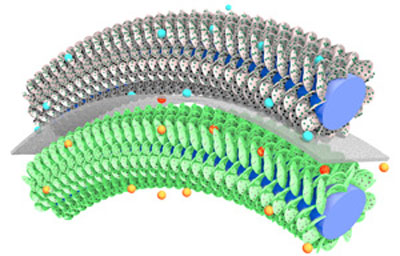Graphene's stabilizling influence on supercapacitors
Supercapacitors can be charged and discharged tens of thousands of times, but their relatively low energy density compared to conventional batteries limits their application for energy storage. Now, A*STAR researchers have developed an ‘asymmetric’ supercapacitor based on metal nitrides and graphene that could be a viable energy storage solution ("All Metal Nitrides Solid-State Asymmetric Supercapacitors").
asymmetric supercapacitor

llustration of the asymmetric supercapacitor, consisting of vertically aligned graphene nanosheets coated with iron nitride and titanium nitride as the anode and cathode, respectively. (©WILEY-VCH Verlag)
A supercapacitor’s viability is largely determined by the materials of which its anodes and cathodes are comprised. These electrodes must have a high surface area per unit weight, high electrical conductivity and capacitance and be physically robust so they do not degrade during operation in liquid or hostile environments.
Unlike traditional supercapacitors, which use the same material for both electrodes, the anode and cathode in an asymmetric supercapacitor are made up of different materials. Scientists initially used metal oxides as asymmetric supercapacitor electrodes, but, as metal oxides do not have particularly high electrical conductivities and become unstable over long operating cycles, it was clear that a better alternative was needed.
Metal nitrides such as titanium nitride, which offer both high conductivity and capacitance, are a promising alternative, but they tend to oxidize in watery environments that limits their lifetime as an electrode. A solution to this is to combine them with more stable materials.
Hui Huang from A*STAR’s Singapore Institute of Manufacturing Technology and his colleagues from Nanyang Technological University and Jinan University, China, have fabricated asymmetric supercapacitors which incorporate metal nitride electrodes with stacked sheets of graphene.
To get the maximum benefit from the graphene surface, the team used a precise method for creating thin-films, a process known as atomic layer deposition, to grow two different materials on vertically aligned graphene nanosheets: titanium nitride for their supercapacitor’s cathode and iron nitride for the anode. The cathode and anode were then heated to 800 and 600 degrees Celsius respectively, and allowed to slowly cool. The two electrodes were then separated in the asymmetric supercapacitor by a solid-state electrolyte, which prevented the oxidization of the metal nitrides.
The researchers tested their supercapacitor devices and showed they could cycle 20,000 times and exhibited both high capacitance and high power density. “These improvements are due to the ultra-high surface area of the vertically aligned graphene substrate and the atomic layer deposition method that enables full use of it,” says Huang. “In future research, we want to enlarge the working-voltage of the device to increase energy density further still,” says Huang.




